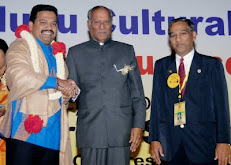Sankranti/ Makara Sankranti/ Pongal Telugu style 13-16/1/2010
Sankranti is a solar event. It is the biggest festival of Indians. Three or four day’s continuous holidays by state government in India. So while dates of all Hindu festivals keep changing as per the Gregorian calendar, the date of Sankranti remains constant, 14 January. Sankranti is celebrated in the Hindu calendar month of Magha. Sankranti is celebrated wherever Indians are with some regional variations.
In India itself, it is known by different names and celebrated with different customs in different parts of the country as follows Makara Sankranti or Sankranti - Uttar Pradesh, Bihar, West Bengal, Orissa, Manipur, Maharashtra, Madhya Pradesh, Andhra Pradesh/Telugus Karnataka and Goa ,Uttarayan- Gujarat and Rajasthan, Lohri - Himachal Pradesh, Punjab ,Pongal - Tamilnadu, Makara Vilakku Festival - Sabarimala Temple.In other countries too the day is celebrated under different names and in different ways:
In Nepal, Tharu people – Maghi,Other people - Maghe Sankranti or Maghe Sakrati,In Thailand - Songkran,In Laos - Pi Ma Lao; In Myanmar - Thingyan
Sankranti is also to honour, worship and to pay respect to the word mother, Saraswati Maa (Goddess of Knowledge). At the start of this significant event, there is also worship for the departed ancestors. The period is also considered an ideal time for aspirants to satisfy "the goals of life". Sankranti has deep spiritual significance and is rooted in an unshakable divine history and identifies a period of enlightenment, peace, prosperity and happiness followed by a period of darkness, ignorance and viciousness with immense sorrow. The worship of Saraswati is for the same reason that they celebrate Vasanta Panchami that represents the first day of spring and falls in.The worship and remembrance of departed/deceased ancestors is done during this Sankranti and is one of the most auspicious days for the Hindus.
Telugus style
It is a four day festival for Telugus
• Day 1 - Bhogi Panduga (Bhogi)-
• Day 2 - Pedda Panduga,(Sankranti)
• Day 3 - Kanuma Panduga (Kanuma)
• Day 4 - Dumulu Panduga (Mukkanuma)
The first day of festival is Bhogi. At dawn people light up a bonfire with several old articles/ coconut dry leaves/ bushes.A day before Sakranthri is known as Boghi. And on Boghi day, Telugus will usually apply a mixture of tumeric powder, green bean paste and sesame oil on our bodies to symbolically remove impurities before gathering with other family members around a bonfire or campfire. These are the regi pallu with petals of flower and coins of money, will be put on the heads of kids(generally younger than 3 years)(like talambralu) to get rid of Dishti(drushti). After which,whole house would be washed/ painted decorated with mugullu. All these events represent the change from old to new.
The second day is Sankranti, it is celebrated by boiling rice with fresh milk and jaggery in new pots, which are topped with brown sugar, cashew nuts and raisins early in the morning and allowing it to boil over the vessel. The new boiled rice is offered to the sun god, a gesture which symbolises thanks to the sun and nature for providing prosperity. It is later served to the people present in the house for the ceremony Followed by praying to their favorite God by offering them sweets and specially selected mixed vegetables and vegetarian food. The Telugus also worship and remembrance of departed ancestors by offerings clothes and their favorite vegetarian food to them (their photos). While most Hindus offer prayers to deceased family members on Deepavali, but the Telugus does it during on this day of Sakranti festival. Telugu sweets such as Ariselu, Boorelu, Gaarelu, Bobbatlu, Pallu java, Sinipakulu are prepared during this important festival. Travel is considered to be inappropriate, as these days are dedicated for re-union of the families. There is belief that ancestors may visit them on this day. Bhajans also organised for them.
The third day Kanuma Panduga (Kanuma) is for offering thanks to cattle, as they help farmer in different ways for agriculture. On this day the cattle are washed or bathed and decorated with paint, flowers and bells. They are fed red sweet rice and sugar cane. People do not eat any non-vegetarian during the first three days of the festival and eat it only on the day of Mukkanuma(Dumulu Panduga).
Modern day’s cattle are vehicles such as cars, Lorries, motorcycles or bicycles are today’s aid to mankind. And on this day what we practice is to wash cars, lorries, motor cycles, children bicycles and conduct thanking prayers for them as for aid in daily life.
Sankranti usually represents all the four days together. On the fourth day or final day people visit their relatives, friends to enjoy the festive season. It is celebrated in almost every village with adventurous games in South India and like in Malaysia in every estates and villages or even in all the Telugu homes.
Referance: Internet
 Venkates Rao(6 years old), Hari Padma(3 years old), Ramana(5 years old), Lakshmi(7 years old), Santini(7 years old) and her sister(4 years old then) from the Ugadi Programme/BGM held on 2/5/1992 at Alor Setar, Kedah, Malaysia.
Venkates Rao(6 years old), Hari Padma(3 years old), Ramana(5 years old), Lakshmi(7 years old), Santini(7 years old) and her sister(4 years old then) from the Ugadi Programme/BGM held on 2/5/1992 at Alor Setar, Kedah, Malaysia. 








.jpg)
.jpg)
.jpg)
.jpg)
.jpg)

